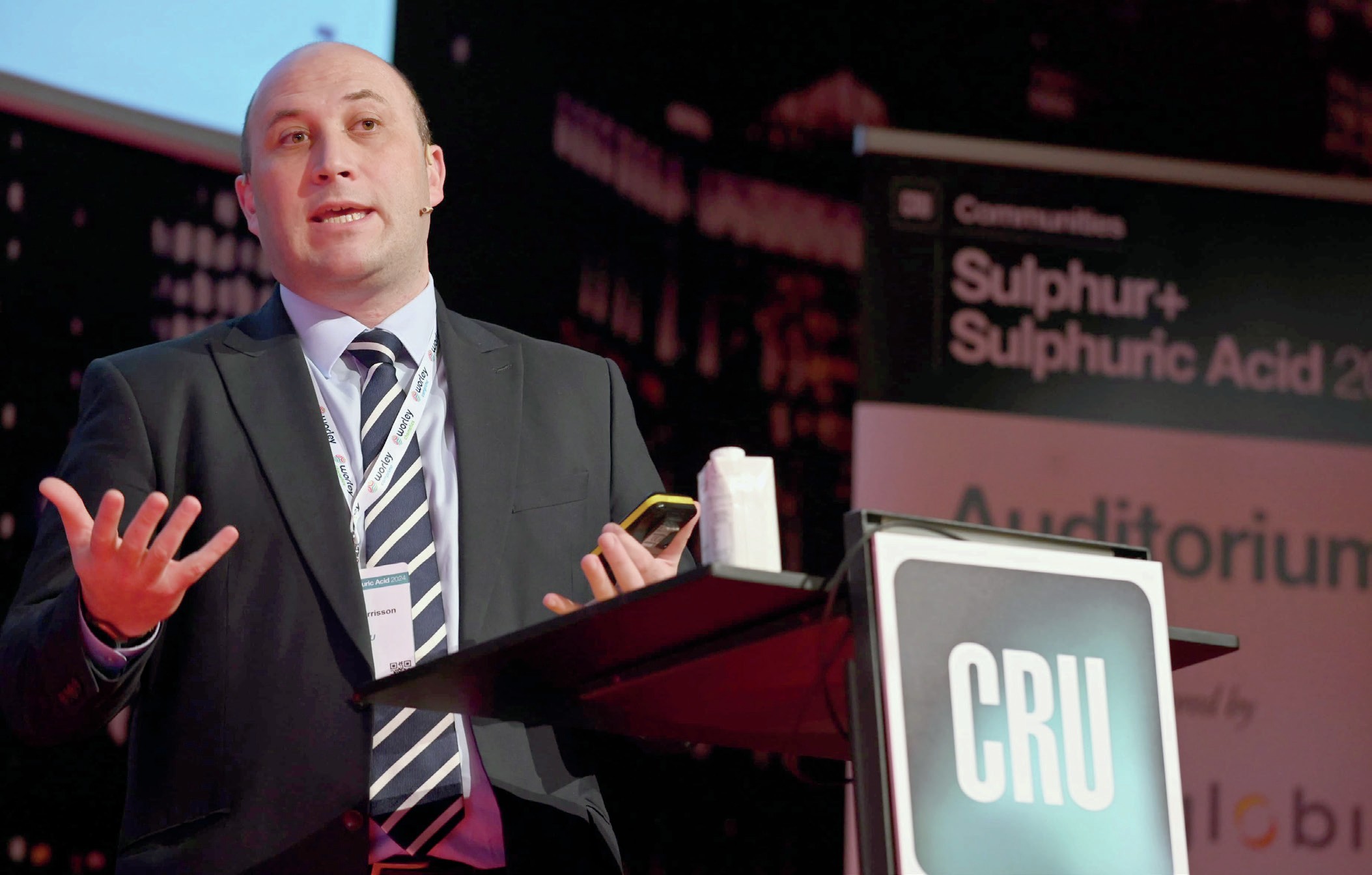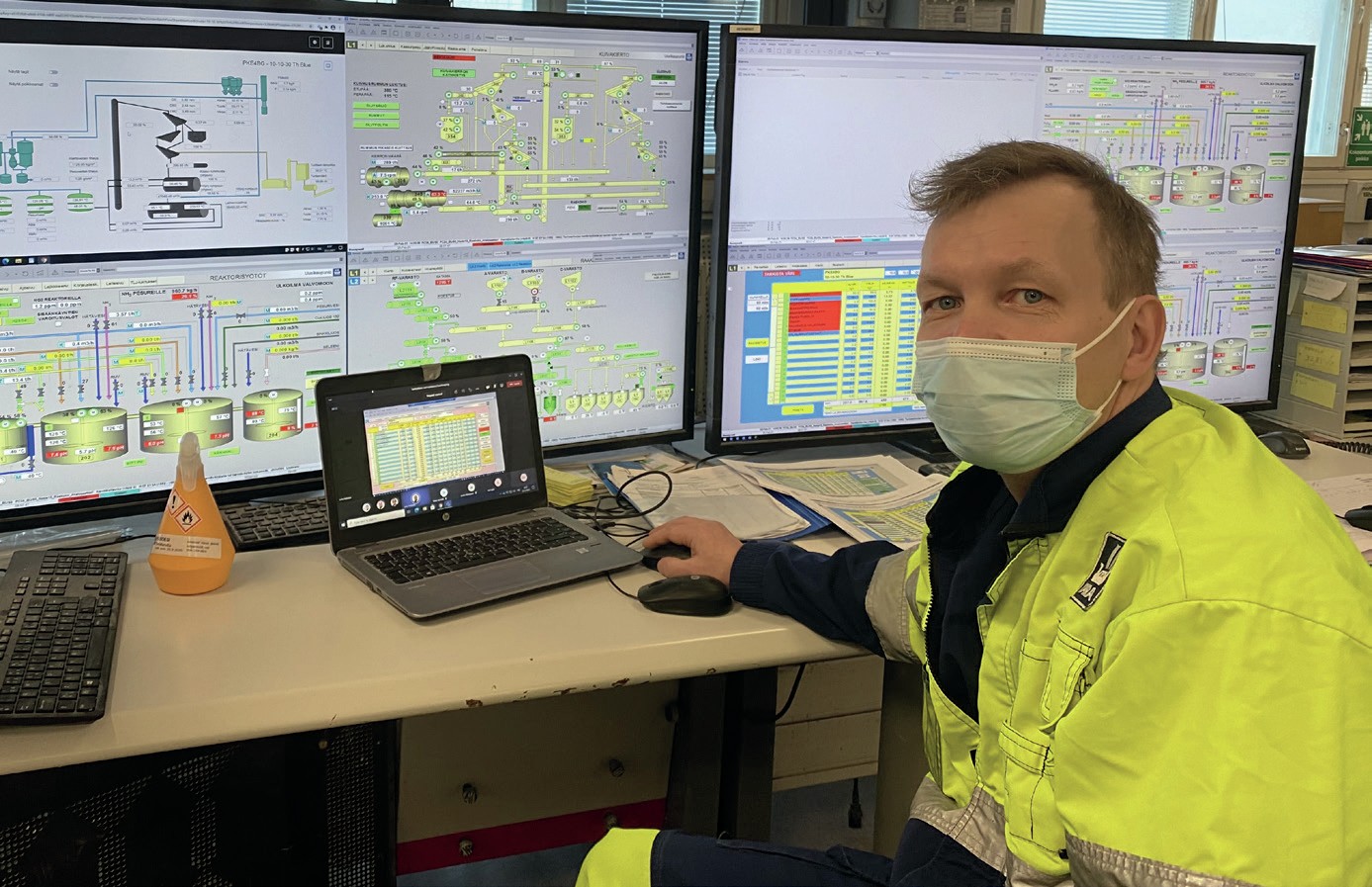Nitrogen+Syngas 393 Jan-Feb 2025

31 January 2025
Digital solutions driving e-methanol market growth
Toyo Engineering Corporation (TOYO), a global leading engineering contractor, has developed two digital solutions: MethaMaster™ and MethaDynamics™. Both tools assist TOYO’s proprietary g-Methanol™ process in producing e-methanol at different phases: the design phase and the operational phase, respectively. Both are based on dynamic simulators that simulate the hourly results of e-methanol production using variable renewable energy 1,000 (VRE).
The variability of energy source is a challenge for plant capacity design as well as for planning daily production. MethaMaster™ is used in the design phase to offer optimum capacity design. MethaDynamics™ is used in the operational phase for production planning to maximise e-methanol production and for automatic operation of the g-Methanol ™ plant, even when utilising VRE.
By combining these two new digital solutions with the g-Methanol™ process to address the new challenges of VRE, TOYO provides seamless support from licensing to operational assistance (Fig. 1).

The g-Methanol™ process
TOYO’s unique MRF-Z™ reactor is the core of its g-Methanol™ process. The MRF-Z™ reactor was originally designed for natural gas-based conventional methanol. With decades of experience as an EPC and licensing business, TOYO is now applying its experience in conventional methanol for the transformation to e-methanol production technology, using its g-Methanol™ process. Fig. 2 summarises the main step developments of TOYO’s methanol technology.
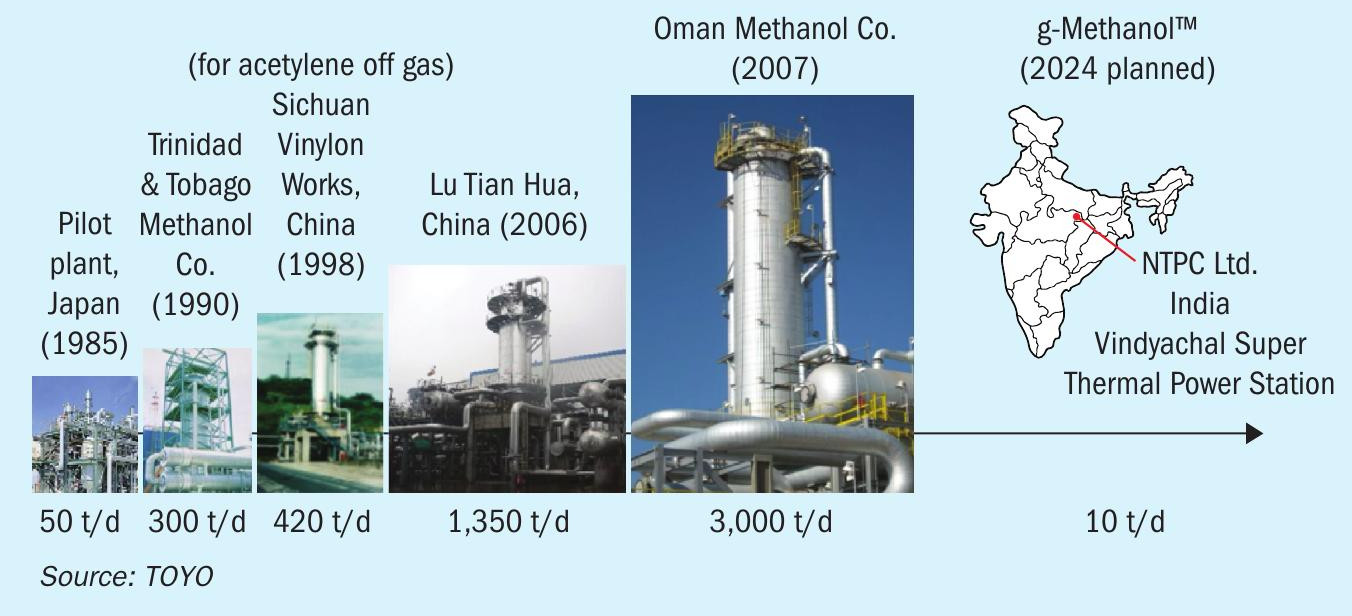
The MRF-Z™ reactor design has the following advantages1:
- reaction heat is recovered as medium pressure steam;
- a high heat transfer coefficient between the syngas and the cooling tube;
- maximises the methanol production per unit volume of catalyst;
- simple removal of catalyst saves time and manpower.
The MRF-Z™ reactor suits exothermic methanol synthesis due to its adaptable surface area and temperature control. Its features align well with e-methanol catalyst limitations: shorter lifetime due to by-product water and more frequent replacement.
As reference of the g-Methanol™ process, a 10 t/d e-methanol production plant is currently being prepared for operation in India.
MethaMaster™
Basic concept
MethaMaster™ offers the optimum configuration and design capacity of the g-Methanol™ plant including the electrolyser, battery and hydrogen storage as parameters of hourly dynamic simulation. Based on an hourly profile of VRE, hundreds of cases of configurations with different design capacities are simulated in a short time. The core of MethaMaster™ is its algorithm that maximises e-methanol production by utilising as much electricity as possible. Detailed examples of outputs include the operational load of the g-Methanol™ plant, the pressure of hydrogen storage, shutdown frequency, excess energy and more.
The basic model configuration of the g-Methanol™ plant in MethaMaster™ is shown in Fig. 3. Based on customer’s project constraints, the configuration, capacity range and other parameters are given.
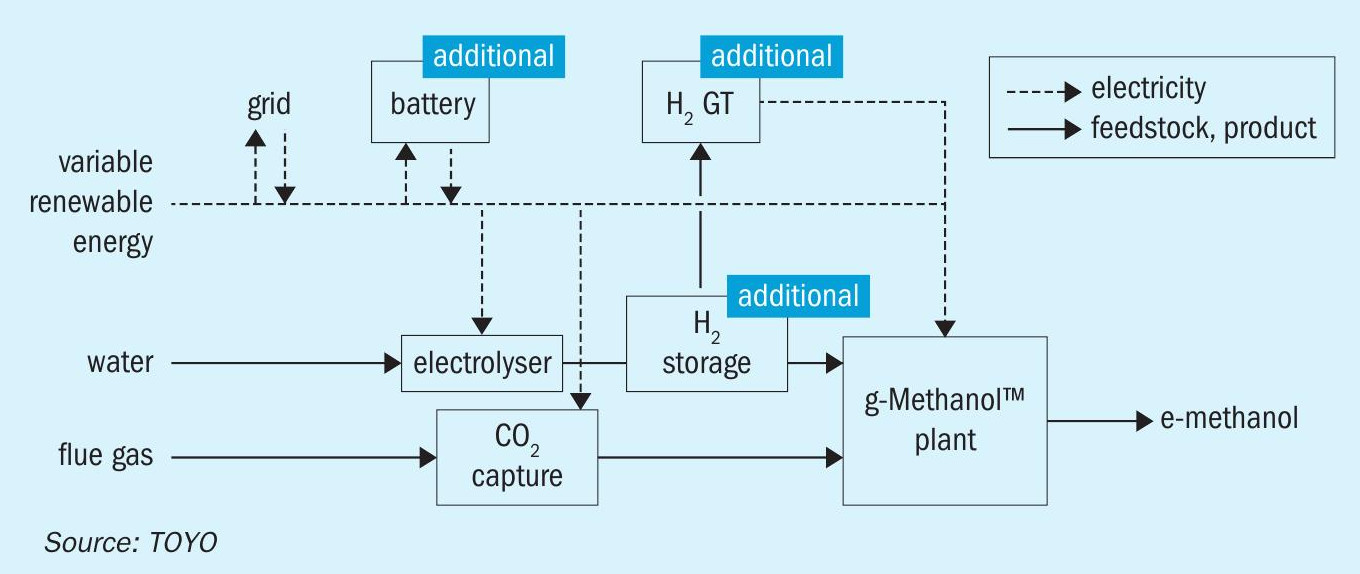
Challenges in the design phase
Due to the fluctuating nature of VRE, batteries or hydrogen storage is required to store electricity or hydrogen when RE generation is insufficient for operation. To maintain the stable operations preferred in conventional plant management, drastic operational load change is undesirable, and situations that could lead to plant shutdown should be avoided. Therefore, setting the capacity of buffer facilities is extremely important. MethaMaster™ allows for the determination of appropriate buffer facilities size based on fluctuations.
The operational load of the g-Methanol™ plant is decided hourly depending on the remaining hydrogen storage to avoid shutdown. Too large storage is not appropriate due to the increase of capital cost, but too small storage cannot store enough hydrogen to avoid shutdown. The trade-off is analysed from the results simulated by many cases of dynamic simulation using MethaMaster™.
Output
MethaMaster™ outputs are listed below:
- hourly g-Methanol™ plant operational load (%);
- hourly pressure in hydrogen storage (barA);
- total shut down frequency and time for a year;
- electricity consumption (kW);
- excess energy: electricity which is not used (kW);
- capex (USD);
- opex (USD).
Those data are used in the calculation of the levelized cost of methanol (LCOM). The best configuration is selected mainly based on the result of production and the LCOM.
Levelised cost of methanol (LCOM)
MethaMaster™ is not only the tool for plant capacity design but also for economics. Based on the results of dynamic simulation, capex, opex and e-methanol production are calculated (equation 1). LCOM represents the production cost of e-Methanol, levelised by annual production adjusted for discount rate.

As MethaMaster™ can calculate capex and opex at any given capacity parameter, e-methanol plant lifetime cost can be estimated. A typical case of e-methanol plant lifetime cost break down is shown in Fig. 4. In this case, electricity cost is separated from the opex. Electricity cost and electrolyser capex account for the majority of the total cost. Hence, reducing both costs are key to reduce LCOM.
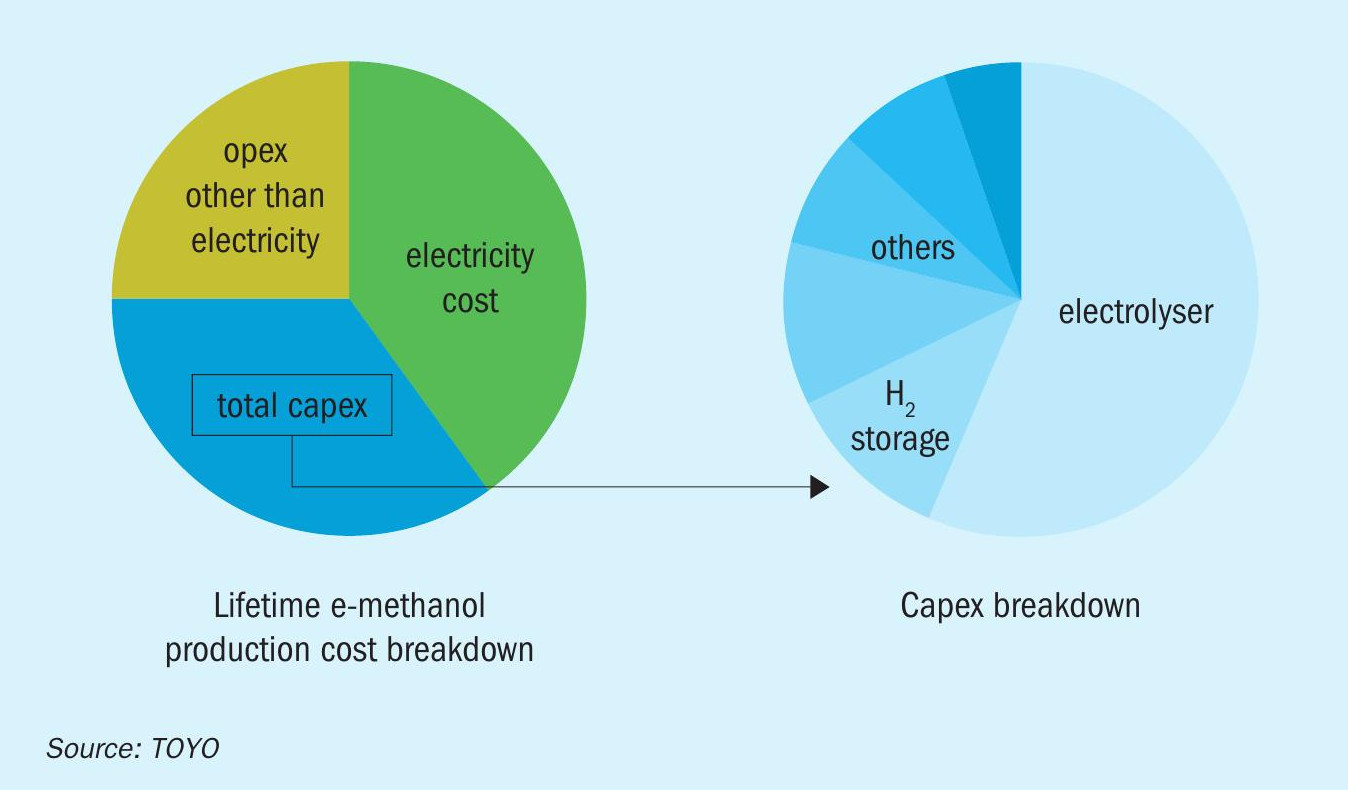
MethaDynamics™
Basic concept
MethaDynamics™ is a highly advanced digital solution meticulously designed to offer comprehensive operational support throughout the entire operational phase of e-methanol production. MethaDynamics™ assists users in achieving optimal operational efficiency by utilising its sophisticated operation support system. This system is specifically tailored to handle the intricate complexities associated with e-methanol production, especially under the VRE.
By taking into account predetermined facility capacities, the current status of the plant, forecasts for renewable energy availability, and e-methanol shipping schedules, MethaDynamics™ is capable of automatically generating the most efficient production plans. These plans are then seamlessly communicated to the control systems of each facility, ensuring that the execution is smooth and uninterrupted. This comprehensive approach ensures that all aspects of the production process are optimised, leading to enhanced efficiency and reliability in e-methanol production.
A sample operation plan created by MethaDynamics™ is shown in Fig. 5.
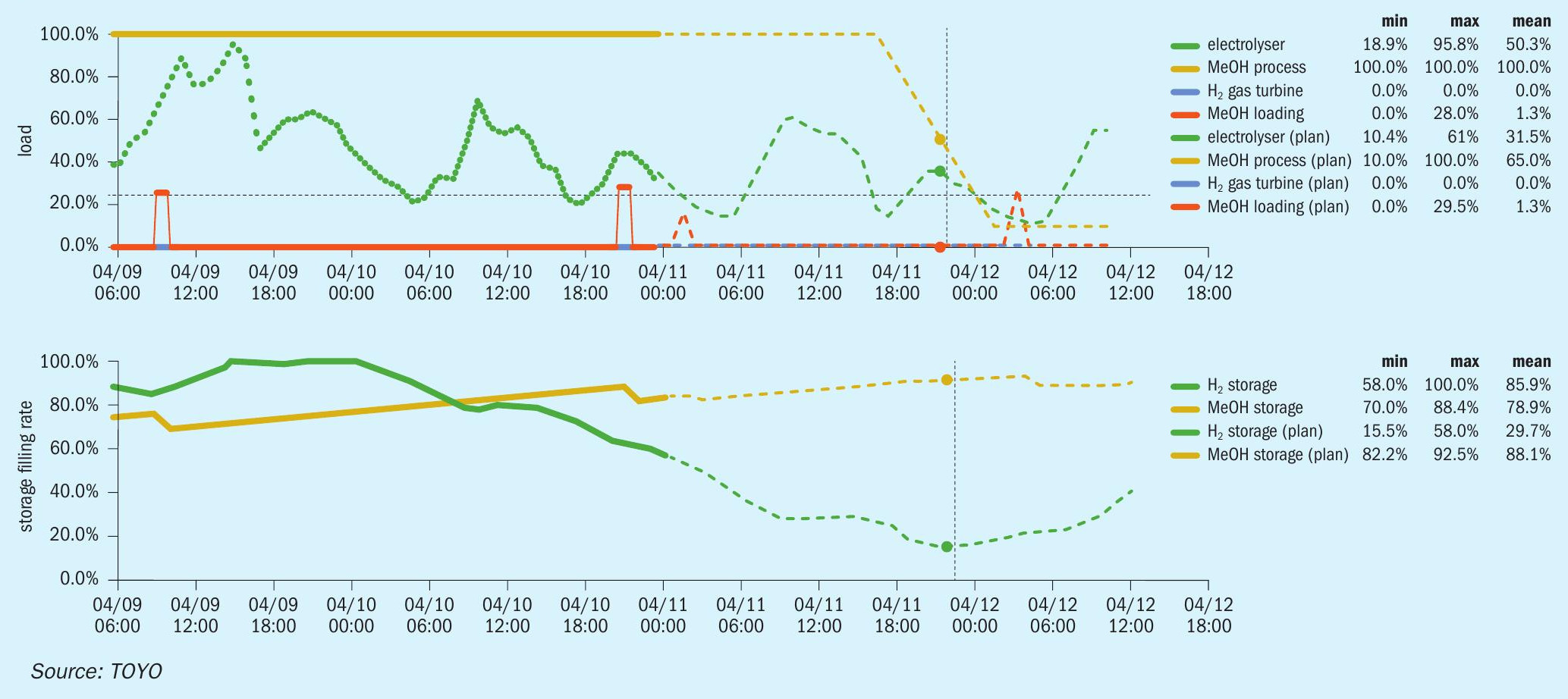
Complex operations under VRE
Efficient production under VRE conditions necessitates meticulous and strategic operation planning. This involves a comprehensive consideration of various critical factors such as predicted power generation, hydrogen storage levels, shipping schedules, and production efficiency at different operational loads.
For instance, if the hydrogen storage is depleted, the g-Methanol™ plant must shut down operations. To prevent such a scenario, it is essential to reduce the plant load in anticipation of decreased power generation, thereby conserving the available hydrogen. Conversely, when the hydrogen storage is full, halting hydrogen production can result in significant losses. Therefore, if an increase in power generation is expected, the plant load should be increased to actively consume the stored hydrogen, ensuring efficient utilisation of resources.
Similarly, if the e-methanol storage is insufficient, shipping operations cannot proceed as planned, necessitating adjustments in production to align with shipping schedules. The consumption rates of raw materials and utilities also vary with changes in the operational load, adding another layer of complexity to the planning process.
Given the inevitable deviations between forecasted and actual power generation, it is crucial to have a dynamic and adaptable operation plan that can respond to real-time conditions. This requires continuous revisions of the plan based on updated forecasts and the actual conditions of 1,000 the plant. The complexity and the need for frequent updates make manual planning impractical, highlighting the necessity of an advanced system like MethaDynamics™. MethaDynamics™ provides the required flexibility and precision, ensuring that the production process remains efficient and responsive to changing conditions.
System architecture
MethaDynamics™ comprises two main components: the Cloud Planner and the On-premises Executor (Fig. 6).
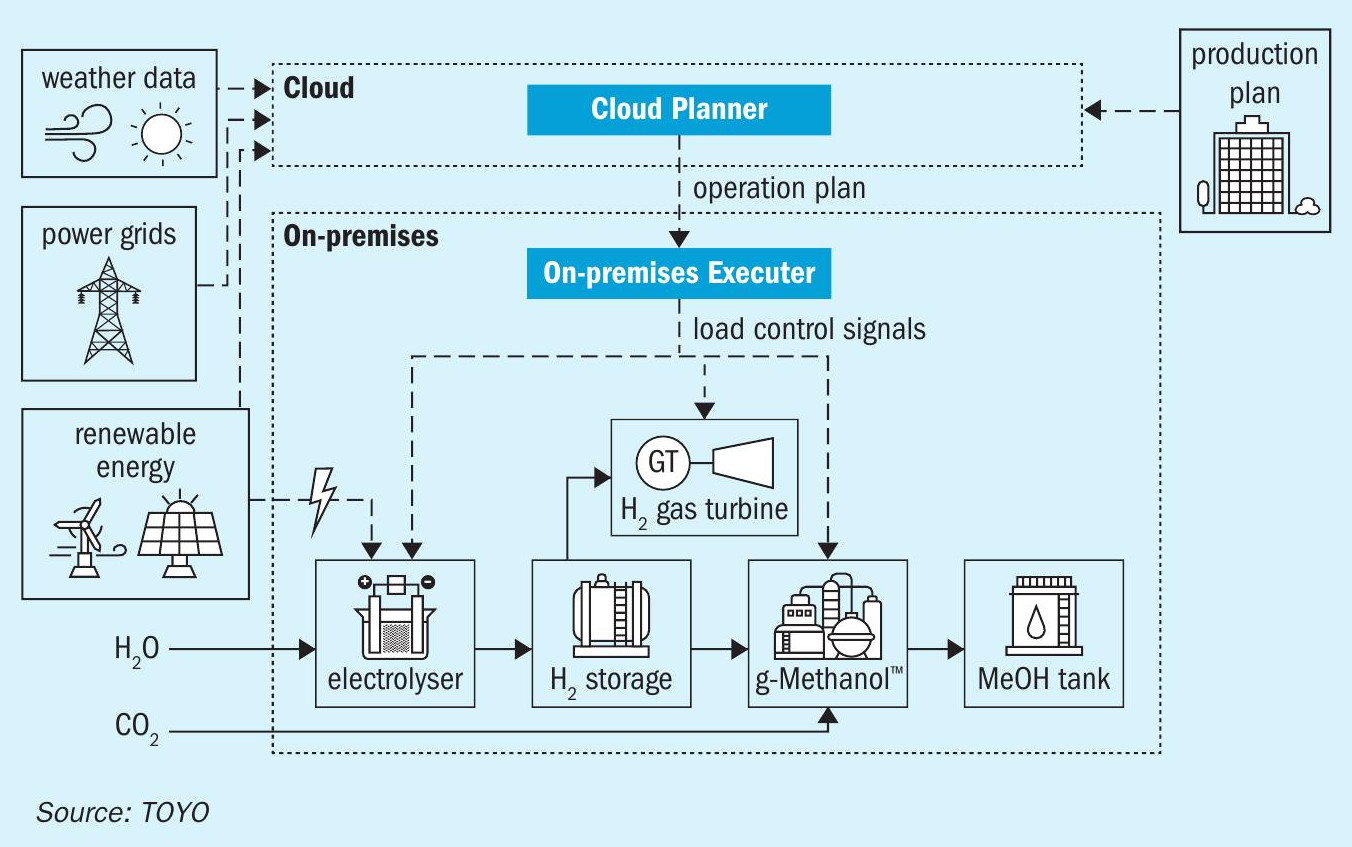
Cloud Planner
This component operates on the cloud, gathering data from a variety of external systems such as weather forecasts, power grid information, statuses of renewable energy facilities, and shipping plans. It periodically generates operational plans that take into account future conditions to a certain extent. Designed for long-term future planning, the cloud system executes cycles at hourly intervals, utilising dynamic and variable computing resources to handle fluctuating demands. It communicates with various external systems over the internet to gather the necessary data and ensure seamless integration. This allows the Cloud Planner to create comprehensive and adaptive plans that can respond to changing conditions and optimise the overall production process.
On-premises Executor
This component operates on-site, receiving plans from the Cloud Planner and issuing commands to adjust the load on each process unit accordingly. It considers detailed constraints to ensure safe and stable operations. Additionally, it collects operational data from the control systems of each process unit and shares this data with the Cloud Planner. This system focuses on precise plan adjustments to meet detailed constraints, operating with execution cycles at minute intervals to ensure timely responses to changing conditions. It relies on stable computing resources and maintains direct communication with the control systems of production facilities to implement operational plans effectively. By doing so, the On-premises Executor ensures that the production process remains efficient and responsive to real-time conditions, thereby enhancing the overall reliability and performance of the e-methanol production system.
Predicting power generation in the near future is significantly more reliable than forecasting power generation over a longer time horizon. This increased reliability necessitates frequent updates to the operation plan to ensure optimal performance. To achieve these frequent updates, automation in operation planning is essential. Automation aids in creating more efficient and responsive plans, effectively managing the complexities associated with operating under fluctuating renewable energy conditions.
MethaDynamics™ is designed to automatically and frequently update operation plans, ensuring that the system remains efficient and responsive. The MethaDynamics™ planning and execution cycle operates as follows (Fig. 7):
1. The amount of power generated by renewable energy sources is updated using the latest forecast information.
2. The operation plan is revised based on the most recent predictions of renewable energy generation and current plant status.
3. The plant operates according to the updated plan, even if there are deviations from the forecast.
4. Actual inventory levels and production amounts are measured and fed back into the system for the next planning cycle.
5. The planning period window advances, preparing for the next cycle of updates.
By automating these processes, MethaDynamics™ ensures that operation plans are continuously optimised, providing efficient and responsive solutions to the challenges posed by renewable energy fluctuations. This automation not only enhances the reliability of the operation plans but also significantly reduces the manual effort required, allowing for more precise and timely adjustments.

MethaDynamics™ brings a new level of efficiency and responsiveness to operation planning, making it an indispensable tool for managing the dynamic and complex environment of renewable energy production.
Conclusion
TOYO’s new digital solutions for e-methanol production from VRE significantly enhance operational efficiency. MethaMaster™ optimises the design phase by buffering power fluctuations using batteries and hydrogen storage, ensuring continuous plant operation, and reducing production costs. MethaDynamics™ streamlines production planning and execution by automating responses to power variability, thus eliminating the complexity of manual adjustments, and improving productivity. Together, these solutions enable more stable and cost-effective e-methanol production. It is anticipated that these digital solutions will strongly support the development of the e-methanol market, contribute to the integration of renewable energy with industrial processes, and support the development of a value chain where e-methanol is increasingly utilised as fuel and chemical feedstock.
Reference



